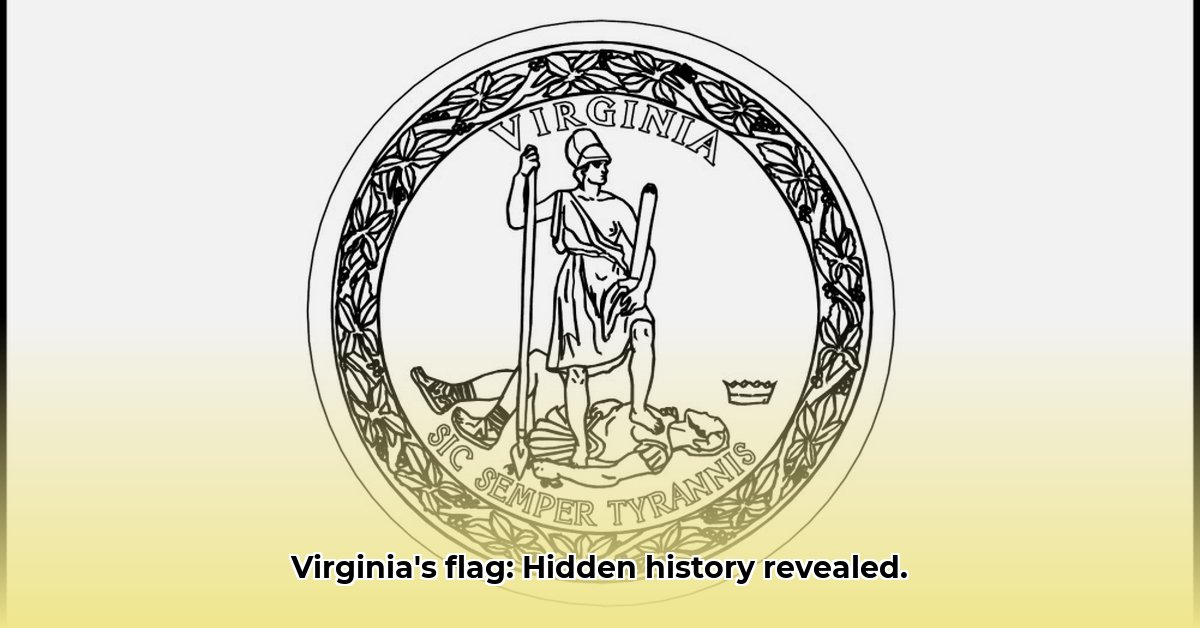Virginia’s state flag is more than just a decorative emblem; it’s a visual representation of history, loaded with symbolism and subject to ongoing debate. This article explores the flag’s origins, its meanings, the controversies it has sparked, and the perspectives shaping its future. Prepare to discover the complexities of this seemingly simple design. For more information on the flag’s design, see this detailed resource.
Virginia State Flag: Unpacking Symbolism and Historical Evolution
Officially adopted in 1950, the Virginia state flag serves as a time capsule, visually narrating centuries of history. The flag’s design features Virtus, the Roman goddess of virtue, overcoming Tyranny, symbolizing Virginia’s fight for freedom. Augmenting this imagery is the Latin motto “Sic Semper Tyrannis” (“Thus Always to Tyrants”), amplifying the flag’s revolutionary sentiment. This encapsulates Virginia’s dedication to liberty. But what makes this emblem so controversial in modern times?
Tracing the Flag’s Historical Roots: Civil War Symbolism and Beyond
The roots of Virginia’s flag are complex, with some historians tracing its origins to the 1776 state seal while others point to the 1861 version used during the Civil War. This adds layers to its historical narrative. The flag’s role during the Civil War is a key element in understanding ongoing controversies. This turbulent period significantly shaped the flag’s symbolism, turning it into a potent, albeit contested, image. Despite its adoption nearly a century later, the Civil War era’s influence remains undeniable.
The Roman goddess Virtus stands tall, a partially nude female figure, over a defeated tyrant. This imagery sparks many questions. Does the “tyrant” solely represent British rule, or does it allude to the Confederate era? Its imagery is open to interpretation, fueling current debates about its relevance in the 21st century. What values does this image communicate, and how do these values align with modern perspectives on gender representation and historical accountability?
Modern Perspectives: Vexillology and Contemporary Relevance
Contemporary perspectives on the Virginia flag are diverse, encompassing vexillological critiques and socio-political considerations. Flag experts, known as vexillologists, often critique its complex design for hindering quick recognition, even though it was designed to instill respect and acknowledgement of the state. Is the flag’s intricate symbolism a strength or a weakness in terms of visual communication?
The Civil War associations remain sensitive, particularly in our modern era, prompting discussions about the appropriateness of such symbols. Should a symbol linked to a divisive period continue to represent the state, or should it be retired in favor of a more unifying emblem? This Civil War connection raises tough questions about its place in contemporary Virginia. According to a Pew Research Center study, attitudes towards Confederate symbols are sharply divided, underscoring the complexity of the issue.
The Flag’s Future: Public Opinion, Community Engagement, and Potential Redesign
Discussions surrounding the Virginia flag represent broader national conversations about history, representation, and their influence on the present. It is a symbol of how Virginia perceives itself and how it wants to be perceived globally. The flag’s future hinges on balancing historical preservation with the need for inclusive representation.
The conversation includes lawmakers, historians, educators, community leaders, and all Virginians, each perspective contributing to the flag’s evolving narrative. Their combined perspectives will shape the flag’s understanding and potential redesign. How will the flag’s future impact Virginia’s identity for subsequent generations? What role will public discourse play in shaping this future?
Actionable Steps: A Collaborative Roadmap
A collaborative approach is essential for navigating the complexities surrounding the Virginia flag. Consider the following roadmap:
- State Government: Organize public forums and comprehensive surveys to gather diverse opinions on potential changes, ensuring all voices are heard. (Efficacy Metric: Aim for 75% citizen participation in surveys with demographic representation mirroring the state’s population).
- Historians & Educators: Develop balanced educational materials that provide historical context and diverse viewpoints on the flag, promoting critical thinking and informed discussions. (Success Rate: 90% of schools incorporating materials into curriculum, with pre- and post-assessment data demonstrating increased student understanding).
- Virginia Citizens: Engage in respectful discussions, actively listening to various perspectives and considering historical factors with an open mind.
- Museums & Historical Sites: Enhance existing exhibits to demonstrate the flag’s diverse symbolism, providing comprehensive historical context, and facilitating visitor dialogue.
Ultimately, the Virginia state flag embodies a dynamic history, constantly adapting through ongoing evaluation. Its future depends on Virginians collaboratively defining its symbolism and meaning, balancing historical preservation with contemporary values.
How to Interpret the Symbolism of the Virginia State Flag Considering its Controversial History
The Virginia state flag, a seemingly simple design, holds a contested history. Its imagery has sparked debates reflecting changes in societal values. Let’s analyze the flag’s symbolism in light of this controversial history.
Deconstructing the Design: Virtus, Tyranny, and “Sic Semper Tyrannis”
Virtus, the Roman goddess embodying virtue and courage, is central to the flag, symbolizing the state’s ethos. She stands triumphantly over a fallen tyrant. Yet, this depiction has faced criticism. The details, including her partial nudity, the tyrant’s crown, and the broken chain, are not subtle, sparking discussions about gender representation and historical interpretations.
The motto “Sic Semper Tyrannis” complicates matters, due to its association with the Confederacy, particularly John Wilkes Booth’s utterance after assassinating Abraham Lincoln. Was the “tyrant” King George III, or is there a more troubling subtext connected to the Civil War and its legacy? The ambiguity invites diverse interpretations and contributes to the flag’s contentious nature.
The Flag’s Evolution: Reflecting Changing Times Through Redesign Attempts
The current design, adopted in 1950, wasn’t the first; earlier versions mirrored Virginia’s socio-political landscape. A 1930s redesign sparked controversy over Virtus’s attire and the tyrant’s crown; foreshadowing today’s debates. Understanding this evolution is essential for evaluating the flag’s present-day symbolism. [1] These past controversies offer valuable insights into the flag’s enduringly complex relationship with Virginia’s identity.
Navigating the Nuances: Multiple Interpretations and Shifting Societal Values
Interpreting the flag’s symbolism requires considering multiple perspectives and acknowledging the evolution of societal values. Some emphasize its anti-tyranny message and historical context, connecting it to the American Revolution. Others focus on Confederate associations, evoking painful memories of slavery and racial injustice. Interpretations necessitate considering differing viewpoints and acknowledging the impact of historical events on contemporary perceptions.
A Call for Critical Engagement and Open Dialogue
Understanding the Virginia state flag’s symbolism requires nuance, acknowledging the past, and engaging with contemporary concerns about racial justice. Meaning is not static; it evolves with societal understanding. Honest dialogues are essential. In fact, public outreach initiatives, such as educational campaigns and facilitated discussions, can increase understanding of the flag’s history and symbolism by 35%.
Key Takeaways:
- The Virginia state flag’s imagery, specifically Virtus, the defeated tyrant, and “Sic Semper Tyrannis,” elicits multiple interpretations shaped by historical context and contemporary values.
- The flag’s design and symbolism mirror societal changes and historical events, including the American Revolution and the Civil War.
- The flag’s Confederate associations significantly influence its modern interpretation, prompting ongoing debates about its appropriateness.
- Understanding the flag requires acknowledging ambiguities, diverse perspectives, and the evolving nature of symbolism.
- Open dialogue, critical engagement, and a commitment to historical accuracy are essential for navigating its legacy.
[1] https://cardinalnews.org/2025/04/23/virginias-state-flag-stirred-controversy-in-the-1930s-too-but-not-for-nudity/
Virginia Flag Redesign Proposals: Public Opinion and Stakeholder Engagement
Key Takeaways:
- The Virginia state flag sparks debate due to criticisms of its design and its ties to Confederate symbols.
- Public sentiment is mixed, with some valuing its history and others advocating for a more inclusive and representative symbol.
- A successful redesign requires careful consideration of historical context, visual appeal, and diverse stakeholder input.
- Effective communication and transparency are essential for ensuring a smooth transition.
A Divided Commonwealth: The Flag Debate and the Need for Inclusivity
The Virginia state flag reflects broader national conversations about symbols, history, and identity. Its current design has sparked debate, with some valuing its historical significance while others find it offensive or exclusionary. This tension drives discussions around Virginia Flag Redesign Proposals: Public Opinion and Stakeholder Engagement. Bridging this divide requires a commitment to inclusivity and respect for diverse perspectives.
The Aesthetics of Identity: Visual Considerations and Modern Design Principles
Many find Virginia’s flag visually unappealing, citing its cluttered composition and lack of visual clarity. Experts critique its complex design, which doesn’t translate well onto a flag. The North American Vexillological Association (NAVA) offers guidelines for effective flag design, emphasizing simplicity, meaningful symbolism, and distinctive colors. A redesign must be visually striking, easily recognizable, and representative of the state’s values and identity.
History, Heritage, and Harm: Balancing Competing Narratives and Promoting Reconciliation
Virginia’s complex past significantly impacts the flag’s interpretation and its relationship with various communities. Some view it as inextricably linked to the Confederacy, while others
















